snow chains SKODA OCTAVIA TOUR 2010 2.G / (1Z) Owner's Manual
[x] Cancel search | Manufacturer: SKODA, Model Year: 2010, Model line: OCTAVIA TOUR, Model: SKODA OCTAVIA TOUR 2010 2.G / (1Z)Pages: 199, PDF Size: 12.09 MB
Page 114 of 199
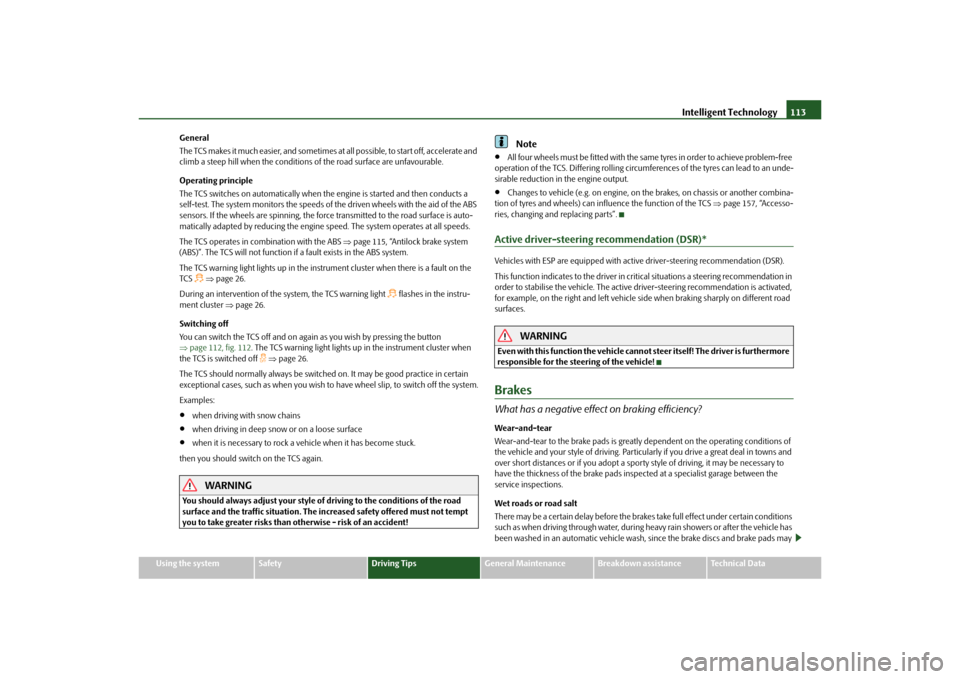
Intelligent Technology113
Using the system
Safety
Driving Tips
General Maintenance
Breakdown assistance
Technical Data
General
The TCS makes it much easier, and sometimes at
all possible, to start off, accelerate and
climb a steep hill when th e conditions of the road surface are unfavourable.
Operating principle
The TCS switches on automatically when th e engine is started and then conducts a
self-test. The system monitors the speeds of the driven wheels with the aid of the ABS
sensors. If the wheels are spinning, the force transmitted to the road surface is auto-
matically adapted by reducing the engine speed. The system operates at all speeds.
The TCS operates in combination with the ABS page 115, “Antilock brake system
(ABS)”. The TCS will not function if a fault exists in the ABS system.
The TCS warning light lights up in the instru ment cluster when there is a fault on the
TCS
page 26.
During an intervention of the system, the TCS warning light
flashes in the instru-
ment cluster page 26.
Switching off
You can switch the TCS off and on again as you wish by pressing the button
page 112, fig. 112 . The TCS warning light lights up in the instrument cluster when
the TCS is switched off
page 26.
The TCS should normally always be switched on. It may be good practice in certain
exceptional cases, such as when you wish to have wheel slip, to switch off the system.
Examples:
when driving with snow chains
when driving in deep snow or on a loose surface
when it is necessary to rock a vehicle when it has become stuck.
then you should switch on the TCS again.
WARNING
You should always adjust your style of driving to the conditions of the road
surface and the traffic situation. The increased safety offered must not tempt
you to take greater risks than otherwise - risk of an accident!
Note
All four wheels must be fitted with the same tyres in order to achieve problem-free
operation of the TCS. Differing rolling circumferences of the tyres can lead to an unde-
sirable reduction in the engine output.
Changes to vehicle (e.g. on engine, on the brakes, on chassis or another combina-
tion of tyres and wheels) can influence the function of the TCS page 157, “Accesso-
ries, changing and replacing parts”.
Active driver-steering recommendation (DSR)*Vehicles with ESP are equipped with active driver-steering recommendation (DSR).
This function indicates to the driver in crit ical situations a steering recommendation in
order to stabilise the vehicle. The active driver-steering recommendation is activated,
for example, on the right and left vehicle si de when braking sharply on different road
surfaces.
WARNING
Even with this function the vehicle cann ot steer itself! The driver is furthermore
responsible for the steering of the vehicle!BrakesWhat has a negative effect on braking efficiency?Wear-and-tear
Wear-and-tear to the brake pa ds is greatly dependent on the operating conditions of
the vehicle and your style of driving. Particularly if you drive a great deal in towns and
over short distances or if you adopt a sporty style of driving, it may be necessary to
have the thickness of the brake pads insp ected at a specialist garage between the
service inspections.
Wet roads or road salt
There may be a certain delay before the brakes take full effect un der certain conditions
such as when driving through water, during heavy rain showers or after the vehicle has
been washed in an automatic vehicle wash , since the brake discs and brake pads may
s2bs.2.book Page 113 Monday, September 27, 2010 9:53 AM
Page 117 of 199
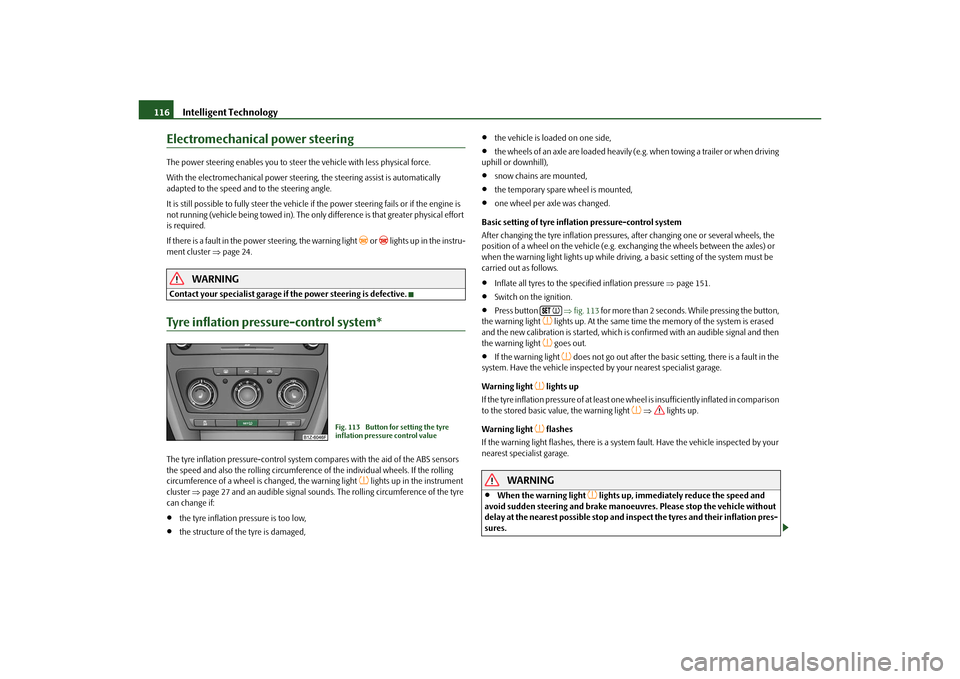
Intelligent Technology
116
Electromechanical power steeringThe power steering enables you to steer the vehicle with le ss physical force.
With the electromechanical power steering , the steering assist is automatically
adapted to the speed and to the steering angle.
It is still possible to fully steer the vehicle if the power steering fails or if the engine is
not running (vehicle being towed in). The only difference is that greater physical effort
is required.
If there is a fault in the power steering, the warning light
or lights up in the instru-
ment cluster page 24.
WARNING
Contact your specialist garage if the power steering is defective.Tyre inflation pressure-control system*The tyre inflation pressure-control system compares with the aid of the ABS sensors
the speed and also the rolling circumference of the individual wheels. If the rolling
circumference of a wheel is changed, the warning light
lights up in the instrument
cluster page 27 and an audible signal sounds. The rolling circumference of the tyre
can change if:
the tyre inflation pressure is too low,
the structure of the tyre is damaged,
the vehicle is loaded on one side,
the wheels of an axle are loaded heavily (e.g. when towing a trailer or when driving
uphill or downhill),
snow chains are mounted,
the temporary spare wheel is mounted,
one wheel per axle was changed.
Basic setting of tyre inflation pressure-control system
After changing the tyre inflation pressures, after changing one or several wheels, the
position of a wheel on the vehicle (e.g. ex changing the wheels between the axles) or
when the warning light lights up while drivin g, a basic setting of the system must be
carried out as follows.
Inflate all tyres to the specified inflation pressure page 151.
Switch on the ignition.
Press button fig. 113 for more than 2 seconds. While pressing the button,
the warning light
lights up. At the same time the memory of the system is erased
and the new calibration is started, which is confirmed with an audible signal and then
the warning light goes out.
If the warning light
does not go out after the basic setting, there is a fault in the
system. Have the vehicle inspected by your nearest specialist garage.
Warning light
lights up
I f t h e t y re i n f l a t i o n p re s s u re o f a t l e a s t o n e wheel is insufficiently inflated in comparison
to the stored basic va lue, the warning light
lights up.
Warning light
flashes
If the warning light flashes, there is a system fault. Have the vehicle inspected by your
nearest specialist garage.
WARNING
When the warning light
lights up, immediately reduce the speed and
avoid sudden steering and brake manoeuvr es. Please stop the vehicle without
delay at the nearest possible stop and in spect the tyres and their inflation pres-
sures.
Fig. 113 Button for setting the tyre
inflation pressure control value
s2bs.2.book Page 116 Monday, September 27, 2010 9:53 AM
Page 153 of 199
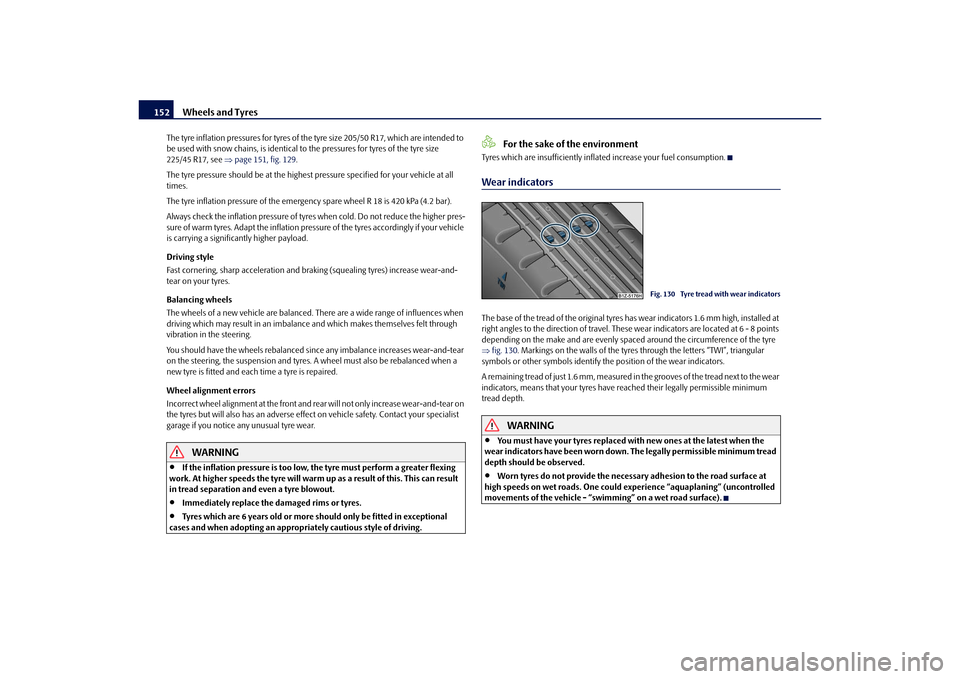
Wheels and Tyres
152
The tyre inflation pressures for tyres of the tyre size 205/50 R17, which are intended to
be used with snow chains, is identical to the pressures for tyres of the tyre size
225/45 R17, see page 151, fig. 129 .
The tyre pressure should be at the highest pressure specified for your vehicle at all
times.
The tyre inflation pressure of the emergency spare wheel R 18 is 420 kPa (4.2 bar).
Always check the inflation pressure of tyres when cold. Do not reduce the higher pres-
sure of warm tyres. Adapt the inflation pressure of the tyres accordingly if your vehicle
is carrying a significantly higher payload.
Driving style
Fast cornering, sharp acceleration and brak ing (squealing tyres) increase wear-and-
tear on your tyres.
Balancing wheels
The wheels of a new vehicle are balanced. There are a wide range of influences when
driving which may result in an imbalance and which makes themselves felt through
vibration in the steering.
You should have the wheels rebalanced si nce any imbalance increases wear-and-tear
on the steering, the suspension and tyres. A wheel must also be rebalanced when a
new tyre is fitted and each time a tyre is repaired.
Wheel alignment errors
Incorrect wheel alignment at the front and re ar will not only increase wear-and-tear on
the tyres but will also has an adverse effect on vehicle safety. Contact your specialist
garage if you notice any unusual tyre wear.
WARNING
If the inflation pressure is too low, the tyre must perform a greater flexing
work. At higher speeds the tyre will warm up as a result of this. This can result
in tread separation and even a tyre blowout.
Immediately replace the damaged rims or tyres.
Tyres which are 6 years old or more should only be fitted in exceptional
cases and when adopting an approp riately cautious style of driving.
For the sake of the environment
Tyres which are insufficiently inflated increase your fuel consumption.Wear indicatorsThe base of the tread of the original tyres has wear indicators 1.6 mm high, installed at
right angles to the direction of travel. These wear indicators are located at 6 - 8 points
depending on the make and are evenly spaced around the circumference of the tyre
fig. 130 . Markings on the walls of the tyres through the letters “TWI”, triangular
symbols or other symbols identify th e position of the wear indicators.
A re m a i n i n g t re a d o f j u s t 1 .6 m m , m e a s u re d i n t h e g ro o v e s o f t he tre a d n e x t t o th e w e a r
indicators, means that your tyres have reached their legally permissible minimum
tread depth.
WARNING
You must have your tyres replaced with new ones at the latest when the
wear indicators have been worn down . The legally permissible minimum tread
depth should be observed.
Worn tyres do not provide the necessary adhesion to the road surface at
high speeds on wet roads. One could experience “aquaplaning” (uncontrolled
movements of the vehicle - “swimming” on a wet road surface).
Fig. 130 Tyre tread with wear indicators
s2bs.2.book Page 152 Monday, September 27, 2010 9:53 AM
Page 156 of 199
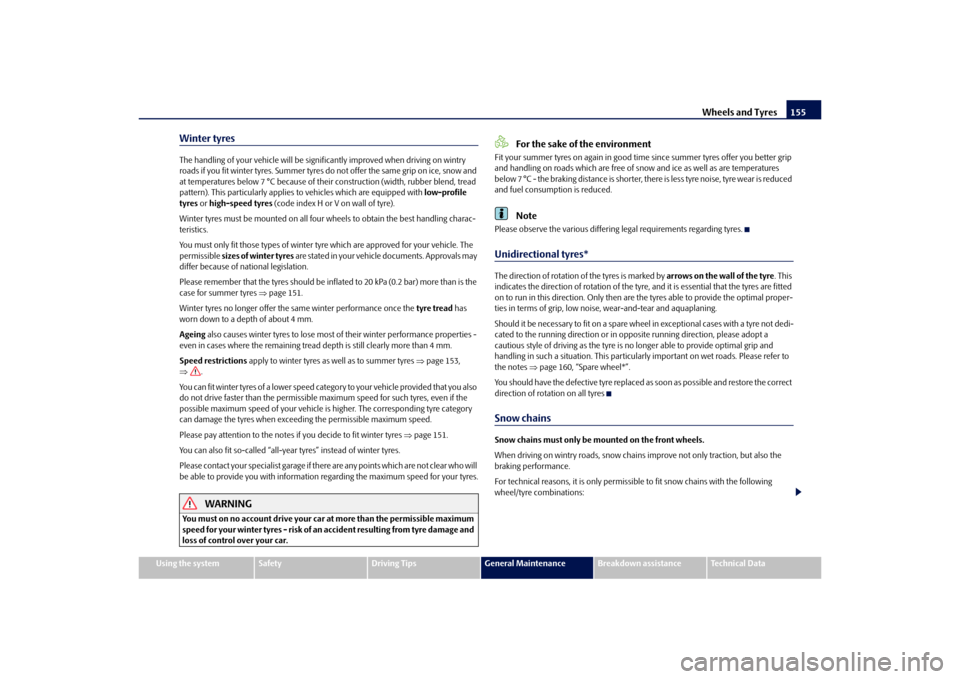
Wheels and Tyres155
Using the system
Safety
Driving Tips
General Maintenance
Breakdown assistance
Technical Data
Winter tyresThe handling of your vehicle will be signif icantly improved when driving on wintry
roads if you fit winter tyres. Summer tyres do not offer the same grip on ice, snow and
at temperatures below 7 °C because of thei r construction (width, rubber blend, tread
pattern). This particularly applies to vehicles which are equipped with low-profile
tyres or high-speed tyres (code index H or V on wall of tyre).
Winter tyres must be mounted on all four wheels to obtain the best handling charac-
teristics.
You must only fit those types of winter tyre which are approved for your vehicle. The
permissible sizes of winter tyres are stated in your vehicle documents. Approvals may
differ because of na tional legislation.
Please remember that the tyres should be inflated to 20 kPa (0.2 bar) more than is the
case for summer tyres page 151.
Winter tyres no longer offer the same winter performance once the tyre tread has
worn down to a depth of about 4 mm.
Ageing also causes winter tyres to lose most of their winter performance properties -
even in cases where the remaining tread depth is still clearly more than 4 mm.
Speed restrictions apply to winter tyres as well as to summer tyres page 153,
.
You can fit winter tyres of a lower speed catego ry to your vehicle provided that you also
do not drive faster than the permissible maximum speed for such tyres, even if the
possible maximum speed of your vehicle is higher. The corresponding tyre category
can damage the tyres when exceeding the permissible maximum speed.
Please pay attention to the notes if you decide to fit winter tyres page 151.
You can also fit so-called “all-year tyres” instead of winter tyres.
Please contact your specialist garage if there are any points which are not clear who will
be able to provide you with information regarding the maximum speed for your tyres.
WARNING
You must on no account drive your car at more than the permissible maximum
speed for your winter tyres - risk of an accident resulting from tyre damage and
loss of control over your car.
For the sake of the environment
Fit your summer tyres on again in good time since summer tyres offer you better grip
and handling on roads which are free of snow and ice as well as are temperatures
below 7 °C - the braking distance is shorter, there is less tyre noise, tyre wear is reduced
and fuel consumption is reduced.
Note
Please observe the various differing legal requirements regarding tyres.Unidirectional tyres*The direction of rotation of the tyres is marked by arrows on the wall of the tyre. This
indicates the direction of rotation of the tyre, and it is essential that the tyres are fitted
on to run in this direction. Only then are the tyres able to provide the optimal proper-
ties in terms of grip, low nois e, wear-and-tear and aquaplaning.
Should it be necessary to fit on a spare wheel in exceptional cases with a tyre not dedi-
cated to the running direction or in oppo site running direction, please adopt a
cautious style of driving as the tyre is no longer able to provide optimal grip and
handling in such a situation. This particular ly important on wet roads. Please refer to
the notes page 160, “Spare wheel*”.
You should have the defective tyre replaced as soon as possible and restore the correct
direction of rotation on all tyresSnow chainsSnow chains must only be mounted on the front wheels.
When driving on wintry roads, snow chains improve not only traction, but also the
braking performance.
For technical reasons, it is only permissi ble to fit snow chains with the following
wheel/tyre combinations:
s2bs.2.book Page 155 Monday, September 27, 2010 9:53 AM
Page 157 of 199
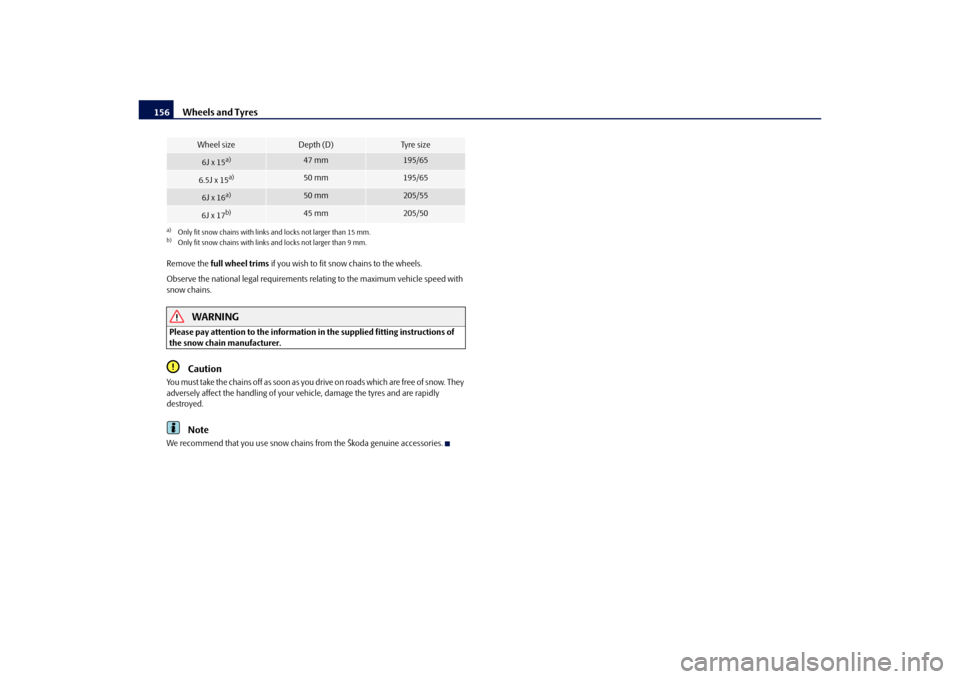
Wheels and Tyres
156
Remove the full wheel trims if you wish to fit snow chains to the wheels.
Observe the national legal requirements re lating to the maximum vehicle speed with
snow chains.
WARNING
Please pay attention to the information in the supplied fitting instructions of
the snow chain manufacturer.
Caution
You must take the chains off as soon as you drive on roads which are free of snow. They
adversely affect the handling of your ve hicle, damage the tyres and are rapidly
destroyed.
Note
We recommend that you use snow chains from the Škoda genuine accessories.
Wheel size
Depth (D)
Ty re s i z e
6J x 15
a)
a)Only fit snow chains with links and locks not larger than 15 mm.
47 mm
195/65
6.5J x 15
a)
50 mm
195/65
6J x 16
a)
50 mm
205/55
6J x 17
b)
b)Only fit snow chains with links and locks not larger than 9 mm.
45 mm
205/50
s2bs.2.book Page 156 Monday, September 27, 2010 9:53 AM
Page 193 of 199
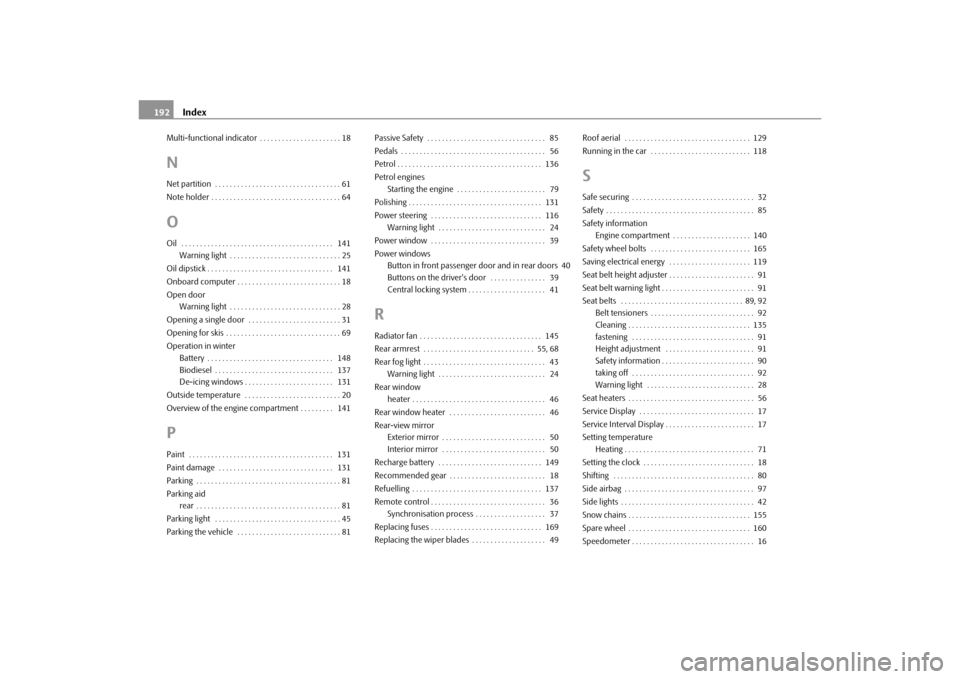
Index
192
Multi-functional indicator . . . . . . . . . . . . . . . . . . . . . . 18NNet partition . . . . . . . . . . . . . . . . . . . . . . . . . . . . . . . . . . 61
Note holder . . . . . . . . . . . . . . . . . . . . . . . . . . . . . . . . . . . 64OOil . . . . . . . . . . . . . . . . . . . . . . . . . . . . . . . . . . . . . . . . . 141
Warning light . . . . . . . . . . . . . . . . . . . . . . . . . . . . . . 25
Oil dipstick . . . . . . . . . . . . . . . . . . . . . . . . . . . . . . . . . . 141
Onboard computer . . . . . . . . . . . . . . . . . . . . . . . . . . . . 18
Open door Warning light . . . . . . . . . . . . . . . . . . . . . . . . . . . . . . 28
Opening a single door . . . . . . . . . . . . . . . . . . . . . . . . . 31
Opening for skis . . . . . . . . . . . . . . . . . . . . . . . . . . . . . . . 69
Operation in winter Battery . . . . . . . . . . . . . . . . . . . . . . . . . . . . . . . . . . 148
Biodiesel . . . . . . . . . . . . . . . . . . . . . . . . . . . . . . . . 137
De-icing windows . . . . . . . . . . . . . . . . . . . . . . . . 131
Outside temperature . . . . . . . . . . . . . . . . . . . . . . . . . . 20
Overview of the engine compartment . . . . . . . . . 141PPaint . . . . . . . . . . . . . . . . . . . . . . . . . . . . . . . . . . . . . . . 131
Paint damage . . . . . . . . . . . . . . . . . . . . . . . . . . . . . . . 131
Parking . . . . . . . . . . . . . . . . . . . . . . . . . . . . . . . . . . . . . . . 81
Parking aid rear . . . . . . . . . . . . . . . . . . . . . . . . . . . . . . . . . . . . . . . 81
Parking light . . . . . . . . . . . . . . . . . . . . . . . . . . . . . . . . . . 45
Parking the vehicle . . . . . . . . . . . . . . . . . . . . . . . . . . . . 81 Passive Safety . . . . . . . . . . . . . . . . . . . . . . . . . . . . . . . . 85
Pedals . . . . . . . . . . . . . . . . . . . . . . . . . . . . . . . . . . . . . . . 56
Petrol . . . . . . . . . . . . . . . . . . . . . . . . . . . . . . . . . . . . . . . 136
Petrol engines
Starting the engine . . . . . . . . . . . . . . . . . . . . . . . . 79
Polishing . . . . . . . . . . . . . . . . . . . . . . . . . . . . . . . . . . . . 131
Power steering . . . . . . . . . . . . . . . . . . . . . . . . . . . . . . 116 Warning light . . . . . . . . . . . . . . . . . . . . . . . . . . . . . 24
Power window . . . . . . . . . . . . . . . . . . . . . . . . . . . . . . . 39
Power windows Button in front passenger door and in rear doors 40
Buttons on the driver's door . . . . . . . . . . . . . . . 39
Central locking system . . . . . . . . . . . . . . . . . . . . . 41
RRadiator fan . . . . . . . . . . . . . . . . . . . . . . . . . . . . . . . . . 145
Rear armrest . . . . . . . . . . . . . . . . . . . . . . . . . . . . . . 55, 68
Rear fog light . . . . . . . . . . . . . . . . . . . . . . . . . . . . . . . . . 43Warning light . . . . . . . . . . . . . . . . . . . . . . . . . . . . . 24
Rear window heater . . . . . . . . . . . . . . . . . . . . . . . . . . . . . . . . . . . . 46
Rear window heater . . . . . . . . . . . . . . . . . . . . . . . . . . 46
Rear-view mirror Exterior mirror . . . . . . . . . . . . . . . . . . . . . . . . . . . . 50
Interior mirror . . . . . . . . . . . . . . . . . . . . . . . . . . . . 50
Recharge battery . . . . . . . . . . . . . . . . . . . . . . . . . . . . 149
Recommended gear . . . . . . . . . . . . . . . . . . . . . . . . . . 18
Refuelling . . . . . . . . . . . . . . . . . . . . . . . . . . . . . . . . . . . 137
Remote control . . . . . . . . . . . . . . . . . . . . . . . . . . . . . . . 36 Synchronisation process . . . . . . . . . . . . . . . . . . . 37
Replacing fuses . . . . . . . . . . . . . . . . . . . . . . . . . . . . . . 169
Replacing the wiper blades . . . . . . . . . . . . . . . . . . . . 49 Roof aerial . . . . . . . . . . . . . . . . . . . . . . . . . . . . . . . . . . 129
Running in the car . . . . . . . . . . . . . . . . . . . . . . . . . . . 118
SSafe securing . . . . . . . . . . . . . . . . . . . . . . . . . . . . . . . . . 32
Safety . . . . . . . . . . . . . . . . . . . . . . . . . . . . . . . . . . . . . . . . 85
Safety information
Engine compartment . . . . . . . . . . . . . . . . . . . . . 140
Safety wheel bolts . . . . . . . . . . . . . . . . . . . . . . . . . . . 165
Saving electrical energy . . . . . . . . . . . . . . . . . . . . . . 119
Seat belt height adjuster . . . . . . . . . . . . . . . . . . . . . . . 91
Seat belt warning light . . . . . . . . . . . . . . . . . . . . . . . . . 91
Seat belts . . . . . . . . . . . . . . . . . . . . . . . . . . . . . . . . . 89, 92 Belt tensioners . . . . . . . . . . . . . . . . . . . . . . . . . . . . 92
Cleaning . . . . . . . . . . . . . . . . . . . . . . . . . . . . . . . . . 135
fastening . . . . . . . . . . . . . . . . . . . . . . . . . . . . . . . . . 91
Height adjustment . . . . . . . . . . . . . . . . . . . . . . . . 91
Safety information . . . . . . . . . . . . . . . . . . . . . . . . . 90
taking off . . . . . . . . . . . . . . . . . . . . . . . . . . . . . . . . . 92
Warning light . . . . . . . . . . . . . . . . . . . . . . . . . . . . . 28
Seat heaters . . . . . . . . . . . . . . . . . . . . . . . . . . . . . . . . . . 56
Service Display . . . . . . . . . . . . . . . . . . . . . . . . . . . . . . . 17
Service Interval Display . . . . . . . . . . . . . . . . . . . . . . . . 17
Setting temperature Heating . . . . . . . . . . . . . . . . . . . . . . . . . . . . . . . . . . . 71
Setting the clock . . . . . . . . . . . . . . . . . . . . . . . . . . . . . . 18
Shifting . . . . . . . . . . . . . . . . . . . . . . . . . . . . . . . . . . . . . . 80
Side airbag . . . . . . . . . . . . . . . . . . . . . . . . . . . . . . . . . . . 97
Side lights . . . . . . . . . . . . . . . . . . . . . . . . . . . . . . . . . . . . 42
Snow chains . . . . . . . . . . . . . . . . . . . . . . . . . . . . . . . . . 155
Spare wheel . . . . . . . . . . . . . . . . . . . . . . . . . . . . . . . . . 160
Speedometer . . . . . . . . . . . . . . . . . . . . . . . . . . . . . . . . . 16
s2bs.2.book Page 192 Monday, September 27, 2010 9:53 AM